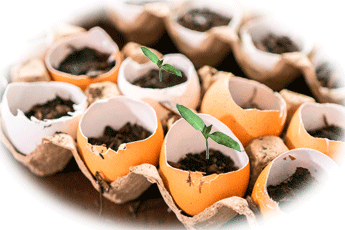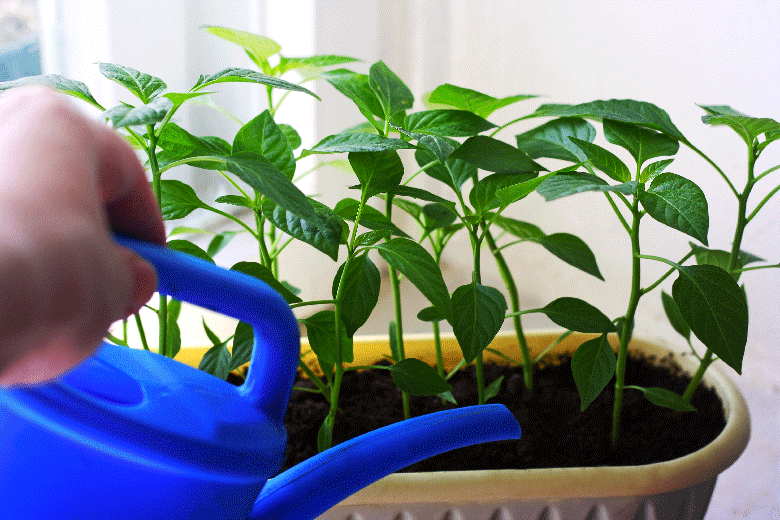 When is fertilising Chillies first required?
When is fertilising Chillies first required?
The Chilli seeds I have recently started don’t need any fertilising. They were planted about a week ago and still need to germinate. So, will they need fertilisation after they sprout? The answer is a resounding no. Seedlings don’t need any fertilization until they have developed their first set of true leaves.
It is precisely for this reason that when you choose a seed starting mix, it should have as low an NPK as possible. I use my own seed starting mix to start seeds. It consists of seed-starting compost with an NPK of 3.4-1-1.5 and worm castings with an NPK of 1: 0: 0. This is pretty low, but even at these levels, the mix could be higher than it needs to be. The seedlings just don’t need any fertilising at all. They can feed themselves through nutrition stored in the endosperm of the seed. This nutrition will be enough until the seedling decides it requires further nourishment.
seeds. It consists of seed-starting compost with an NPK of 3.4-1-1.5 and worm castings with an NPK of 1: 0: 0. This is pretty low, but even at these levels, the mix could be higher than it needs to be. The seedlings just don’t need any fertilising at all. They can feed themselves through nutrition stored in the endosperm of the seed. This nutrition will be enough until the seedling decides it requires further nourishment.
When this happens, the seedling will develop its first set of true leaves to begin photosynthesis. It will also expand its root system to extract nutrients from its growing medium. This is precisely when additional fertilisation needs to be added. Not too much though. Over-fertilising Chilles can be bad for seedlings. Caution needs to be exercised
Adding the first fertilizer

Liquid fertiliser
Once seedlings have developed their first set of true leaves, I will repot them for the first time. I typically pot seedlings into two-inch pots filled with my own potting mix. This mix consists of all-purpose compost, coir soil and perlite. I will also start fertilising the seedlings with half-strength Chilli Focus. The NPK for Chilli Focus is 2.7: 1: 4.4.
When the seedlings are roughly the same size as their 2-inch pots, I pot them on again. This time into 3-inch containers. I will still use the same potting mix, but now, instead of feeding the plants half-strength Chilli Focus, I change to 5 ml per litre of water. This dosage is what the manufacturers recommend for young seedlings.
instead of feeding the plants half-strength Chilli Focus, I change to 5 ml per litre of water. This dosage is what the manufacturers recommend for young seedlings.
Before they reached this stage, I would have only given them 2.5 ml per litre at every second watering. This amount would be more than adequate. Remember that the seedling will also extract nutrition from the potting mix.
I will pot the seedlings on only one more time before I harden them off. I typically pot them on into 13 cm (one-litre pots). Once again, this will be with the same potting mix, but I will change fertilisers from Chilli Focus to one higher in nitrogen to encourage foliage growth. I continue to use this fertilizer until the seedlings get hardened off. I will then change to yet another fertiliser. The amount of fertiliser given to the plants needs to be upped both in quantity and strength. We will be equipping the plants with what they need to get to the important part of reaching maturity.
A change in gear

Upping the dose
And change it does. Once I have hardened the young plants off, I start preparing the pots where they will spend the rest of the season. I now move on to a fertilizer called Vitax V4. This fertilizer has an NPK of 5.3: 7.5: 10. My main focus now is root development. I prepare the pots by adding 3 to 4 tablespoons of fertilizer, a handful of garden lime and 4.5 gallons of potting soil. Coconut coir can also be added. To add it, I reduce the soil content. I used this fertiliser last year and was impressed with the results. So much so that I have made it my standard for final potting on
handful of garden lime and 4.5 gallons of potting soil. Coconut coir can also be added. To add it, I reduce the soil content. I used this fertiliser last year and was impressed with the results. So much so that I have made it my standard for final potting on
Not that I will be resting on my laurels. I am also trying something new for the first time this season. A friend was kind enough to give me a bag of horse manure. I have made sure it is well-rotted and will be trying it in my final potting later this season. It will be interesting to see how the horse manure and Vitax mixes compare
Before the plants develop buds, they will be surface fed with Vitax V4. To do this, I will intermittently use a trowel to dig in a tablespoon, two inches below the top of the potting mix. I will then ensure the plant is well watered to fertilise the roots. I will also do foliar spraying with seaweed extract in between
Finally
At the first sign of buds, I will switch to another fertiliser – Chempak 4 – to encourage blooming and fruit set. This fertiliser has a high potassium level. Its NPK is 15 -15 – 30. It is a water-soluble fertiliser and is applied at a dosage of two scoops (about 30 grams) per 5 litres of water. It is simply poured into the pots from the top.
And that is the way it will remain for the remainder of the season. The plants will get Chempak 4 at every second watering. They will not need any more fertilisation. The only thing I can give the plants after that is TLC to ensure they will give the best they can. I am sure they will!
